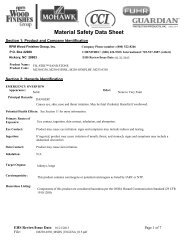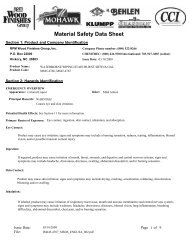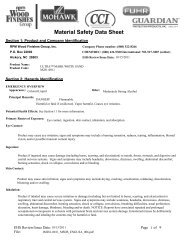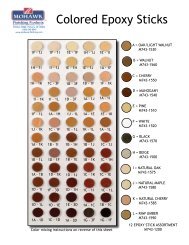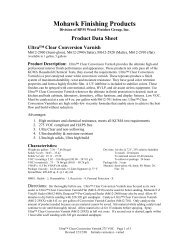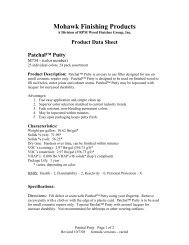MSDS - Mohawk Finishing Products
MSDS - Mohawk Finishing Products
MSDS - Mohawk Finishing Products
- No tags were found...
You also want an ePaper? Increase the reach of your titles
YUMPU automatically turns print PDFs into web optimized ePapers that Google loves.
Material Safety Data SheetSection 1: Product and Company IdentificationRPM Wood Finishes Group, Inc. Company Phone number: (800) 522-8266P.O. Box 22000CHEMTREC: (800) 424-9300 International: 703-527-3887 (collect)Hickory, NC 2860305/22/2013EHS Review/Issue Date:Product Name:Product Code:WATER CLEAR ACRYLIC LACQUER SATINM102-0427Section 2: Hazards IdentificationEMERGENCY OVERVIEWAppearance: Cloudy LiquidOdor:Strong SolventPrincipal Hazards:DANGER! Extremely Flammable.Causes eye, skin, nose and throat irritation. Harmful or fatal if swallowed. Harmful if inhaled. Vapor harmful.Potential Health Effects: See Section 11 for more information.Primary Routes of Exposure:Eye Contact:Product may cause eye damage; signs and symptoms may include burns, vision impairment, permanent corneal damage and/orsoft tissue damage.Ingestion:Skin Contact:Product if ingested may cause damage (including burns, scarring, and ulcerization) to mouth, throat, stomach, and digestive andcentral nervous systems. Signs and symptoms may include headache, drowsiness, dizziness, swelling, abdominal discomfort,burning sensation, shock or collapse, convulsions and/or bleeding. Post-ingestion vomitous in the lungs may cause chemicalpneumonia.Product may cause skin damage; signs and symptoms may include blistering, burns and/or possible scarring. May be harmful ifabsorbed through the skin.Inhalation:Product if inhaled may cause severe irritation or damage (including but not limited to burns, scarring, and ulcerization) torespiratory tract and central nervous system. Signs and symptoms may include weakness, headache, drowsiness, dizziness,swelling, abdominal discomfort, burning sensation, shock or collapse, convulsions, breathing difficulties, nasal perforation,ulceration, heart damage, blindness, bleeding and/or death. Serious risk of suffocation when in confined area. NOTICE: Reportshave associated repeated and prolonged occupational overexposure to solvents with permanent brain and nervous systemdamage. Intentional misuse by deliberately concentrating and inhaling the contents may be harmful or fatal.EHS Review/Issue Date: 05/22/2013Page 1 of 9File:IM102-0427_<strong>MSDS</strong>_ENGUSA_009.pdf
Product Name:Material Safety Data SheetWATER CLEAR ACRYLIC LACQUER SATINTarget Organs:kidneys, nervous systemCarcinogenicity:This product contains carcinogens or potential carcinogens as listed by IARC or NTP.Hazardous Listing:Components of this product are considered hazardous per the OSHA Hazard Communication Standard (29 CFR1910.1200).Section 3: Composition/Information on Ingredientsacetoneisobutyl acetatepropanealkyd resinisobutanem-xylenepolyketone resinacrylic polymerethylbenzeneo-xylenen-butyl acetateethanoltolueneformaldehydeethyl acrylatebenzenecadmiumarsenicChemical CAS Percent Composition67-64-1110-19-074-98-6proprietary75-28-5108-38-3proprietaryproprietary100-41-495-47-6123-86-464-17-5108-88-350-00-0140-88-571-43-27440-43-97440-38-230 - 5010 - 2010 - 201 - 101 - 101 - 101 - 101 - 101 - 101 - 101 - 10< 1< 0.1< 0.1< 0.1< 0.1< 0.1< 0.1Section 4: First Aid MeasuresEye Contact:If exposure occurs, flush the affected eye for at least 20 minutes. Tilt the head to prevent chemical from transferring to theuncontaminated eye. Seek medical attention immediately after flushing.EHS Review/Issue Date: 05/22/2013Page 2 of 9File:IM102-0427_<strong>MSDS</strong>_ENGUSA_009.pdf
Product Name:Material Safety Data SheetWATER CLEAR ACRYLIC LACQUER SATINIngestion:Do not induce vomiting. Dilute with water or milk. Never give fluids if the victim is unconscious or having convulsions. Seekmedical attention immediately. Contact Poison Control Center immediately.Skin Contact:If exposure occurs, flush the affected area thoroughly with water for at least 15 minutes. Destroy contaminated clothing and shoes.Seek medical attention immediately.Inhalation:Remove to fresh air. If not breathing, administer CPR until help arrives or the victim starts to breathe on his own. If breathing isdifficult, give oxygen. Seek medical attention immediately.Section 5: Fire Fighting MeasuresExtinguishing Media:Use alcohol foam, dry chemical, carbon dioxide or any Class B fire extinguishing agent. Water may be unsuitable for extinguishingfires. Water may be used to cool and prevent the rupture of containers that are exposed to the heat from a fire.<strong>Products</strong> of Combustion:Protection of Firefighters / Explosion Hazards:Evacuate all persons from the fire area to a safe location. Move non-burning material, as feasible, to a safe location as soon aspossible. Fire fighters should be protected from potential explosion hazards while extinguishing the fire. Wear self-containedbreathing apparatus (SCBA) and full fire-fighting protective clothing. Thoroughly decontaminate all protective equipment after use.Containers of this material may build up pressure if exposed to heat (fire). Use water spray to cool fire-exposed containers. Usewater spray to disperse vapors if a spill or leak has not ignited. DO NOT extinguish a fire resulting from the flow of flammableliquid until the flow of the liquid is effectively shut off. This precaution will help prevent the accumulation of an explosive vapor-airmixture after the initial fire is extinguished.Section 6: Accidental Release MeasuresEHS Review/Issue Date: 05/22/2013Page 3 of 9File:IM102-0427_<strong>MSDS</strong>_ENGUSA_009.pdf
Product Name:Material Safety Data SheetWATER CLEAR ACRYLIC LACQUER SATINSection 7: Handling and StorageHandling:Storage:Contents under pressure. Do not puncture, incinerate, or discard in a compactor. Do not store above 120°F, or in direct sunlight.Intentional misuse by deliberately concentrating and inhaling vapors may be harmful or fatal. Empty containers may retain productresidue or vapor. Do not pressurize, cut, weld, braze, solder, drill, grind, or expose container to heat, flame, sparks, static electricity,or other sources of ignition.Section 8: Exposure / Personal ProtectionOSHA 29 CFR 1910.1000 Air Contaminants – Tables:ChemicalCASZ-1 PEL(units as noted)Z-2 PEL(PPM)Z-3StatusSpecificallyRegulated see:ACGIH TLV(units as noted)acetoneisobutyl acetatepropanealkyd resinisobutanem-xylenepolyketone resin67-64-1110-19-074-98-6proprietary75-28-5108-38-3proprietary2400 MGM3 (1000 PPM)700 MGM3 (150 PPM)1800 MGM3 (1000 PPM)435 MGM3 (100 PPM)500 PPM150 PPM1000 PPM100 PPMacrylic polymerproprietaryethylbenzeneo-xylenen-butyl acetateethanoltolueneformaldehydeethyl acrylatebenzenecadmiumarsenic100-41-495-47-6123-86-464-17-5108-88-350-00-0140-88-571-43-27440-43-97440-38-2435 MGM3 (100 PPM)435 MGM3 (100 PPM)710 MGM3 (150 PPM)1900 MGM3 (1000 PPM)100 MGM3 (25 PPM)200 PPM10 PPM0.1 MGM329 CFR 1910.104829 CFR 1910.102829 CFR 1910.102729 CFR 1910.1018100 PPM100 PPM150 PPM1000 PPM20 PPM5 PPM0.5 PPM0.002 MGM30.01 MGM3EHS Review/Issue Date: 05/22/2013Page 4 of 9File:IM102-0427_<strong>MSDS</strong>_ENGUSA_009.pdf
Product Name:Material Safety Data SheetWATER CLEAR ACRYLIC LACQUER SATINEngineering Controls:Eye / Face Protection:Skin Protection:Respiratory Protection:A NIOSH-approved air-purifying respirator with the appropriate cartridge may be appropriate under certain circumstances whereairborne concentrations are expected to exceed permissible exposure limits. Protection provided by air-purifying respirators islimited. Use a positive-pressure, air supplied respirator if there is potential for an uncontrolled release, exposure levels are notknown or any other circumstances where air-purifying respirators may not provide adequate protection.General Hygiene Considerations:Section 9: Physical and Chemical PropertiesPhysical State:Odor:Odor Threshold:pH:Freezing Point:Boiling Point:Flash Point ( o F):Evaporation Rate:Flammability (solid, gas):Upper Flammability Limit:Lower Flammability Limit:Vapor Pressure:Vapor Density:Cloudy LiquidStrong SolventNot determined.Not determined.Not determined.Not determined.-144 (CALC.)Not determined.Not determined.Not determined.Not determined.Not determined.Not determined.EHS Review/Issue Date: 05/22/2013Page 5 of 9File:IM102-0427_<strong>MSDS</strong>_ENGUSA_009.pdf
Product Name:Material Safety Data SheetWATER CLEAR ACRYLIC LACQUER SATINSpecific Gravity:Weight per Gallon (lbs):Solubility (water):Partition Coefficient (n-octanol/water):Auto-ignition Temperature:Coating VOC g/l:Coating VOC lbs/gal:Material VOC g/l:Material VOC lbs/gal:Solids VOL%:Solids WT %:0.766.3Not determined.Not determined.Not determined.563.64.69369.833.0810.3814.99Contains Photochemically Reactive Solvent.VOC data per US EPA guidelines. Some states and localities have guidelines more stringent than federal regulations.Aerosol coating product category codes and applicable reactivity limits are displayed on product labels per 40 CFR 59.507.Section 10: Stability and ReactivityStability:Conditions to Avoid/Incompatible Materials:Hazardous Decomposition <strong>Products</strong>:EHS Review/Issue Date: 05/22/2013Page 6 of 9File:IM102-0427_<strong>MSDS</strong>_ENGUSA_009.pdf
Product Name:Material Safety Data SheetWATER CLEAR ACRYLIC LACQUER SATINSection 11: Toxicology InformationChemical CAS IARC NTPacetone 67-64-1isobutyl acetatepropanealkyd resinisobutane110-19-074-98-6proprietary75-28-5m-xylene 108-38-3polyketone resinproprietaryacrylic polymerproprietaryethylbenzene100-41-4o-xylene95-47-6n-butyl acetate123-86-4ethanol64-17-5 * *toluene108-88-3formaldehyde50-00-0**ethyl acrylate140-88-5benzene71-43-2**cadmium7440-43-9*arsenic7440-38-2*Toxicological evaluation of this product as a whole has not been performed. Individual components that are potential or knowncarcinogens are listed above.Section 12: Ecological InformationEHS Review/Issue Date: 05/22/2013Page 7 of 9File:IM102-0427_<strong>MSDS</strong>_ENGUSA_009.pdf
Product Name:Material Safety Data SheetWATER CLEAR ACRYLIC LACQUER SATINSection 13: Disposal ConsiderationsSection 14: Transportation InformationDOT Basic description:UN1950, AEROSOLS, FLAMMABLE, 2.1See 49 CFR 172.101 for Special Provisions, Packaging, and Quantity Limitations.Section 15: Regulatory InformationChemical NameCASCERCLACERCLA RQEPCRA EHSEPCRA TPQSARA 313TSCADSLEINECSProposition 65WHMISacetone67-64-1*5000 LBS* * **isobutyl acetate110-19-0* 5000 LBS****propane74-98-6***alkyd resinproprietaryisobutane75-28-5***m-xylene108-38-3*1000 LBS*****polyketone resinproprietaryacrylic polymerproprietaryethylbenzene 100-41-4*1000 LBS******o-xylene95-47-6*1000 LBS*****n-butyl acetate123-86-4*5000 LBS****ethanol64-17-5*100 LBS*****toluene108-88-3*1000 LBS******formaldehyde50-00-0*100 LBS * 500 LBS******ethyl acrylate140-88-5*1000 LBS******benzene71-43-2*10 LBS******cadmium7440-43-9*10 LBS******arsenic7440-38-2 *1 LBS******WARNING: This product contains a chemical known to the state of California to cause cancer and birth defects, orother reproductive harm.EHS Review/Issue Date: 05/22/2013Page 8 of 9File:IM102-0427_<strong>MSDS</strong>_ENGUSA_009.pdf
Product Name:Material Safety Data SheetWATER CLEAR ACRYLIC LACQUER SATINSection 16: Other InformationHMIS Codes Health 2 Flammability 4 Reactivity 0Key to Abbreviations:* Item appears on indicated list (or inventory)ACGIHAmerican Conference of Governmental Industrial HygienistsCASChemical Abstract Service Registry NumberCERCLAComprehensive Environmental Response, Compensation, and Liability ActCERCLA RQ CERCLA Reportable QuantityCFRCode of Federal RegulationsCPRCardiopulmonary resuscitationDSLDomestic Substances List of CanadaEINECSEuropean Inventory of Existing Chemical SubstancesEPCRAEmergency Planning and Community Right-to-know ActEPCRA EHS EPCRA Extremely Hazardous SubstanceEPCRA TPQ EPCRA Threshold Planning Quantityo FFahrenheit degreesg/lGrams per litergalGallonsIARCInternational Agency for Research on Cancerlbs or LBS PoundsMGM3Milligrams per cubic meterMIRMaximum Incremental Reactivity<strong>MSDS</strong>Material Safety Data SheetNCPWHMIS Non-Controlled ProductNIOSHNational Institute of Occupational Safety and HealthNTPNational Toxicology ProgramOSHAOccupational Safety and Health AdministrationPELPermissible Exposure LimitPPMParts per millionProposition 65 California's Safe Drinking Water and Toxic Enforcement ActSARASuperfund Amendments and Reauthorization ActTLVThreshold Limit ValueTSCAToxic Substances Control ActUSEPAUnited States Environmental Protection AgencyVOCVolatile Organic CompoundVOLVolumeWTWeightWHMISCanadian Workplace Hazardous Materials Information SystemUNUnited NationsEHS Review/Issue Date: 05/22/2013Page 9 of 9File:IM102-0427_<strong>MSDS</strong>_ENGUSA_009.pdf



